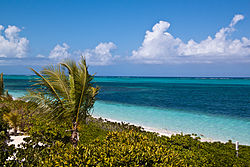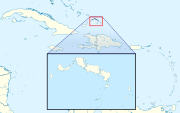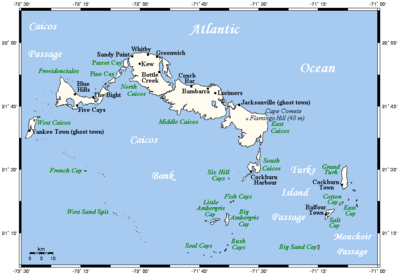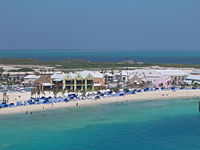Difference between revisions of "Turks and Caicos Islands"
(→Geography) |
|||
| Line 1: | Line 1: | ||
{{Infobox overseas | {{Infobox overseas | ||
|name=Turks and Caicos Islands | |name=Turks and Caicos Islands | ||
| + | |picture=Turtle Cove Providenciales Beach.jpg | ||
| + | |picture caption=Turtle Cove, Providenciales | ||
|flag=Flag of the Turks and Caicos Islands.svg | |flag=Flag of the Turks and Caicos Islands.svg | ||
|arms=Coat-of-arms-of-the-Turks-and-Caicos-Islands.svg | |arms=Coat-of-arms-of-the-Turks-and-Caicos-Islands.svg | ||
| − | |map image= | + | |map image=Turks and Caicos Islands location detail.svg |
| − | |capital= | + | |capital=Cockburn Town |
| − | |largest town= | + | |largest town=Providenciales |
|area=238 square miles | |area=238 square miles | ||
|population=44,819 | |population=44,819 | ||
Latest revision as of 11:30, 5 April 2020
| Turks and Caicos Islands (British overseas territory) | |
 Turtle Cove, Providenciales | |
|---|---|

| |
| | |
| Area: | 238 square miles |
| Population: | 44,819 (2010) |
| Capital: | Cockburn Town |
| Time zone: | GMT -5 |
| Dialling code: | +1-649 |
| TLD: | .tc |
The Turks and Caicos Islands are a British overseas territory consisting of two groups of tropical islands in the Caribbean Sea; the larger Caicos Islands and the smaller Turks Islands. The territory is known for tourism and as an offshore financial centre.
The Turks and Caicos Islands lie southeast of Mayaguana in the Bahamas island chain and north of the island of Hispaniola. Cockburn Town, the capital since 1766, is situated on Grand Turk Island. The islands have a total land area at high tide of 238 square miles or at low tide, 366 square miles. The islands are geographically appurtenant to the Bahamas, an independent Commonwealth realm, but are politically a separate entity.
The total population is about 45,000, of whom approximately 22,500 live on Providenciales in the Caicos Islands.
Contents
History
The Turks Islands are named after the Turk's-cap cactus (Melocactus communis), and the Caicos Islands after the native Lucayan term "caya hico", meaning string of islands. The first inhabitants of the islands were Arawakan-speaking Taíno people who crossed over from Hispaniola at some time between 500 to 800. Together with Tainos who crossed over from Cuba to the southern Bahamas around the same time, these people became the Lucayans. Around 1200 the Turks and Caicos Islands were resettled by Classical Taínos from Hispaniola.
In 1492, Columbus began the European discovery and conquest of the West Indies. The Spaniards soon came to the islands and began capturing the Taínos and the Lucayans to serve as slaves to replace the largely depleted native population of Hispaniola. The southern Bahama Islands, including the Turks and Caicos Islands, were completely depopulated by about 1513, and remained so until the 17th century.[1][2][3][4][5]
The first documented European to sight the islands was Spanish conquistador Juan Ponce de León, who did so in 1512. During the 16th, 17th and 18th centuries, the islands passed from Spanish, to French, to British control, but none of the three powers established any settlement at that stage.
For several decades around the turn of the 18th century the Turks and Caicos Islands became popular pirate hideouts. Bermudian salt collectors settled the Turk Islands around 1680. In 1765–1783 they were under French occupation and again after the French captured the archipelago in 1783. After the American Revolution (1775–1783) many loyalists fled to Caribbean colonies, including (in 1783) the first settlers on the Caicos Islands; cotton became an important crop briefly.
In 1799, both the Turks and the Caicos island groups were annexed by Britain as part of the Bahamas.
In 1841 the Trouvadore, a Spanish ship engaged in the slave trade, wrecked off the coast of East Caicos, one of the larger Caicos Islands. One hundred and ninety-two captive Africans survived the sinking and made it to shore where, under British rule, the slave trade was illegal. These survivors were apprenticed to trades for one year then settled mostly on Grand Turk Island. An 1878 letter documents the "Trouvadore Africans" and their descendants as constituting an essential part of the "labouring population" on the islands. In 2004 marine archaeologists rediscovered a wreck, called the "Black Rock Ship", that subsequent research has suggested may be that of the Trouvadore. This suggestion was further supported when a marine archaeology expedition funded by National Oceanographic and Atmospheric Administration in November 2008 confirmed that the wreck comprises artefacts of which the style and date of manufacture support the association of this wreck with that of the Trouvadore. The wreckage has, however, not been identified with absolute certainty.[6]
In 1848, the Turks and Caicos were declared a separate colony under a council president. The last incumbent was maintained in 1873 when the islands were made part of Jamaica colony; in 1894 the chief colonial official was restyled commissioner. In 1917, Canadian Prime Minister Robert Borden suggested that the Turks and Caicos join Canada, but this suggestion was rejected by British Prime Minister David Lloyd George. The islands remained a dependency of Jamaica until 1959.
On 4 July 1959, the islands were again a separate colony, the last commissioner being restyled Administrator, but the governor of Jamaica remained the governor of the islands. Until 31 May 1962, they were one of the constitutive parts of the Federation of the West Indies.
When Jamaica was granted independence from Britain in August 1962, the Turks & Caicos Islands became a crown colony. From 1965, the governor of the Bahamas was also governor of the Turks and Caicos Islands and oversaw affairs for the islands. When the Bahamas gained independence in 1973, the Turks and Caicos received their own governor (the last administrator was restyled). In 1974, Canadian New Democratic Party MP Max Saltsman tried to use his Private Member's Bill to create legislation to annex the islands to Canada, but it did not pass in the Canadian House of Commons.[7] This was not to be the last time that discussions have occurred about a cessation to Canada.
From 1950 to 1981, the United States had a missile tracking station on Grand Turk. In the early days of the American space programme, NASA used it. After his three earth orbits in 1962, American astronaut John Glenn successfully landed in the nearby ocean and was brought back ashore at this island.
In recent decades the islands have become an important off-shore finance centre, reliant on the favourable tax treatment for such companies based in the territory.
Geography
The two island groups are in the North Atlantic Ocean, southeast of the Bahamas, north of Hispaniola. The two distinct island groups are separated by the Turks Passage.
The two groups and the Bahamas together comprise the "Lucayan Archipelago. The Caicos Islands are separated by the Caicos Passage from the closest Bahamian islands, Mayaguana and Great Inagua.
The eight main islands and more than 299 smaller islands have a total land area of 238 square miles, primarily of low, flat limestone with extensive marshes and mangrove swamps and 128 square miles of beach front. The weather is usually sunny and relatively dry, but suffers frequent hurricanes. The islands have limited natural fresh water resources; private cisterns collect rainwater for drinking. The primary natural resources are spiny lobster, conch and other shellfish.
Caicos Islands
- Main article: Caicos Islands
- Providenciales: the best known of the Turks and Caicos Islands is the centre of the tourism industry with a wide range of hotels, restaurants, attractions and facilities.
- Middle Caicos and North Caicos represent the best of the environment, with lush green woodlands, the biggest cave network in the Caribbean on Middle Caicos, cottage pond and flamingo pond in North Caicos and a vast range of plant life and birdlife.
- South Caicos is the fishing centre. It has the historic Cockburn harbour and the natural phenomenon of the boiling hole.
- Parrot Cay privately owned
- Pine Cay privately owned
- West Caicos – until recently uninhabited; being developed as a resort
Turks Islands
- Main article: Turks Islands
The Turks Islands form a chain that stretches north–south. The estimated population is 5,753 on the two main islands, the only inhabited islands of the group:
- Grand Turk – has the capital of the territory
- Salt Cay
Mouchoir Bank
16 miles east of the Turks Islands and separated from them by Mouchoir Passage is the Mouchoir Bank. Although it has no emergent cays or islets, some parts are very shallow and the water breaks on them. Mouchoir Bank is part of the Turks and Caicos Islands and falls within its Exclusive Economic Zone.
Government
The Turks and Caicos Islands are a British overseas territory, ruled by a Governor appointed by the Queen. The capital, the seat of the Governor and formerly of the Assembly, is Cockburn Town on Grand Turk, far from the main population centre, Providenciales.
The territory's autonomous system of government was suspended in August 2009 after several ministers and members of the House of Assembly were discovered to be involved in widespread corruption. As a result, full administrative and legislative power were vested in the Governor.
The judicial branch of government is headed by a Supreme Court and appeals are heard by the court of appeals and final appeals by the United Kingdom's Judicial Committee of the Privy Council. The Chief Justice of the Supreme Court was Gordon Ward. The islands also have a Court of Appeal with a President and at least two Justices of Appeal.
People
Eight of the thirty islands in the territory are inhabited, with a total population in mid-2006 of about 32,000. One-third of the population is under 15 years old, and only 4% are 65 or older. In 2000 the population was growing at a rate of 3.55% per year, with 14.46 migrants per 1,000 population and 25.65 births per 1,000 population, offset by 4.57 deaths per 1,000 population. The infant mortality rate was 18.66 deaths per 1,000 live births and the life expectancy at birth was 73.28 years (71.15 years for males, 75.51 years for females). The total fertility rate was 3.25 children born per woman. The annual population growth rate is 2.82%.
Some 90% of the population are of Afro-Caribbean race and the remainder mixed race or white.
The population speaks English and Turks and Caicos Islands Creole. Due to its close proximity to Cuba and Hispaniola, large Haitian Creole and Spanish-speaking communities have developed in the territory due to immigration, both legal and illegal, from Creole-speaking Haiti and from Spanish-speaking Cuba and Dominican Republic.[8]
Culture
The Turks and Caicos Islands are known for "ripsaw music". The islands are known for their annual Music and Cultural Festival showcasing many local talents and other dynamic performances by many music celebrities from around the Caribbean and United States.
The island's most popular sports are fishing, sailing, football and cricket (which is the national sport).
Turks and Caicos cuisine is based primarily around seafood, especially conch. Two common dishes, whilst not traditionally 'local', are conch fritters and conch salad.[9]
Economy
The main areas earning towards the islands' GDPare Hotels & Restaurants, Financial Services, Construction, Wholesale & Retail Trade and Health & Social Work. Most capital goods and food for domestic consumption are imported.
In 2006, major sources of government revenue included Import Duties (37%), Stamp Duties from Property Transactions (20%), Work Permits and Residency Fees (9%) and Accommodation Tax (9%). The territory's GDP as of late 2006 is approximately US$722 million (per capita $17,112), with an inflation rate of 3.7%.
The territory's currency is the United States dollar, with a few government fines (such as airport infractions) being payable in pounds sterling. Most commemorative coin issues are denominated in crowns.
The primary agricultural output is limited amounts of maize, beans, cassava (tapioca) and citrus fruits. Fish and conch are the only significant export, with some $169.2 million of lobster, dried and fresh conch, and conch shells exported in 2000, primarily to the United Kingdom and the United States. In recent years, however, the catch has been declining.
The islands import food and beverages, tobacco, clothing, manufacture and construction materials, primarily from the United States and the United Kingdom. Imports totalled $581 million in 2007.
Tourism
The United States was the leading source of tourists in 1996, accounting for more than half of the 87,000 visitors; another major source of tourists is Canada. Tourist arrivals had risen to 264,887 in 2007.[10]
The government is pursuing a two-pronged strategy to increase tourism. Upscale resorts are aimed at the wealthy, while a large new cruise ship port and recreation centre has been built for the masses visiting Grand Turk. Turks and Caicos Islands has one of the longest coral reefs in the world, making it a premier diving destination.
The French vacation village company of Club Mediterannée has an all-inclusive adult resort called 'Turkoise' on one of the main islands.
Providenciales is home to a restaurant scene popular among tourists. There has been a recent trend towards authentic local tastes, with on-the-beach spots such as Da Conch Shack (run by popular Canadian island resident John Macdonald) attracting locals and tourists alike in droves.
In an apparent effort to boost tourism during the Caribbean low season of late summer, the Turks and Caicos Tourist Board have organised and hosted an annual series of concerts called the Turks & Caicos Music and Cultural Festival since summer of 2003.[11] Held in a temporary bandshell at The Turtle Cove Marina in The Bight on Providenciales, this festival lasts about a week and has featured several notable international recording artists.[12] More than 10,000 people attend annually.[12]
References
- ↑ Paul Albury. (1975) The Story of the Bahamas. MacMillan Caribbean. ISBN 0-333-17131-4 pp. 34–37
- ↑ Michael Craton. (1986) A History of the Bahamas. San Salvador Press. ISBN 0-9692568-0-9 pp. 17, 37–39
- ↑ Julian Granberry and Gary S. Vescelius. (2004) Languages of the Pre-Columbian Antilles. The University of Alabama Press. ISBN 0-8173-5123-X pp. 80–86
- ↑ William F. Keegan. (1992) The People Who Discovered Columbus: The Prehistory of the Bahamas. University Press of Florida. ISBN 0-8130-1137-X pp. 25, 48–62, 86, 170–173, 212–213, 220–223
- ↑ Carl Ortwin Sauer. (1966, Fourth printing, 1992) The Early Spanish Main. University of California Press. ISBN 0-520-01415-4 pp. 159–160, 191
- ↑ Randolph E. Schmid, Associated Press, November 25, 2008.
- ↑ "Biography from City Of Cambridge's Hall of Fame". City.cambridge.on.ca. http://www.city.cambridge.on.ca/cs_pubaccess/hall_of_fame.php?aid=41. Retrieved 2011-07-31.
- ↑ Languages of Turks and Caicos Islands from www.ethnologue.com
- ↑ 'Turks and Caicos Cuisine' from www.visittci.com
- ↑ "Department of Economic Planning & Statistics". Depstc.org. http://www.depstc.org/quickstats/qstat2.html. Retrieved 2009-08-15.
- ↑ "The Turks and Caicos Music & Cultural Festival". 2008-04-21. http://www.musicfestival.tc/. Retrieved 2008-08-07.
- ↑ 12.0 12.1 "The Turks and Caicos Music & Cultural Festival News Release". 2008-04-21. Archived from the original on 2008-08-04. http://web.archive.org/web/20080804034317/http://www.musicfestival.tc/go/en/news-info--ID--67.html. Retrieved 2008-08-07.




